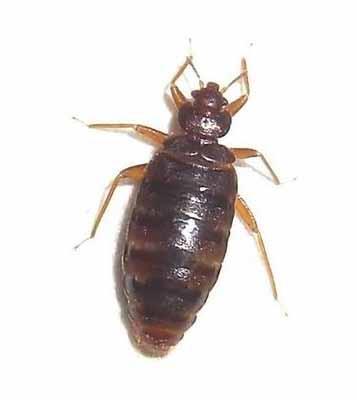Bed Bug Knowledge Library
Below is a list of important Bed Bug PDF documents.
Bed bugs are small, brownish, flattened insects that feed solely on the blood of animals. The common bed bug, Cimex lectularius, is the species most adapted to living with humans. It has done so since ancient times. Bed bugs are mentioned in medieval European texts and in classical Greek writings back to the time of Aristotle. Other bed bug species prefer to feed on wild hosts, especially bats and birds.
AC_AX_RunContent( 'width','610','height','367','src','https://www.youtube.com/v/exvAhBOhsl0&hl=en_US&fs=1&','type','application/x-shockwave-flash','allowscriptaccess','always','allowfullscreen','true','movie','https://www.youtube.com/v/exvAhBOhsl0&hl=en_US&fs=1&' ); //end AC code
Where do bed bugs occur?
 Bed bugs and their relatives occur nearly worldwide. Bed bugs became relatively scarce during the latter part of the 20th century, but their populations have resurged in recent years, particularly throughout parts of North America, Europe, and Australia. They are most abundant in rooms where people sleep, and they generally hide nearest the bed or other furniture used for sleeping. Bed bugs are most active in the middle of the night, but when hungry, they will venture out during the day to seek a host. Their flattened bodies allow them to conceal themselves in cracks and crevices around the room and within furniture. Favored hiding sites include the bed frame, mattress and box spring. Clutter around the room offers additional sites for these bugs to hide, and increases the difficulty in eliminating bed bugs once they have become established.
Bed bugs and their relatives occur nearly worldwide. Bed bugs became relatively scarce during the latter part of the 20th century, but their populations have resurged in recent years, particularly throughout parts of North America, Europe, and Australia. They are most abundant in rooms where people sleep, and they generally hide nearest the bed or other furniture used for sleeping. Bed bugs are most active in the middle of the night, but when hungry, they will venture out during the day to seek a host. Their flattened bodies allow them to conceal themselves in cracks and crevices around the room and within furniture. Favored hiding sites include the bed frame, mattress and box spring. Clutter around the room offers additional sites for these bugs to hide, and increases the difficulty in eliminating bed bugs once they have become established.
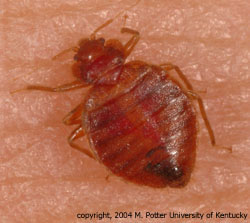 Adult bed bugs are about 3/16-inch long and reddish brown, with oval, flattened bodies. They are sometimes mistaken for ticks or cockroaches. The immatures (nymphs) resemble the adults, but are smaller and lighter in color.Bed bugs do not fly, but can move rapidly over floors, walls, ceilings and other surfaces. Female bed bugs lay their eggs in secluded areas, depositing 1, 2 or more eggs per day and hundreds during a lifetime. The eggs are tiny, whitish, and hard to see on most surfaces without magnification (individual eggs are about the size of a dust speck). When first laid, the eggs are sticky, causing them to adhere to surfaces. Newly hatched nymphs are straw-colored and no bigger than a pinhead. As they grow, they molt (shed their skin) five times before reaching maturity. A blood meal is needed between each successive molt. Under favorable conditions (70-80°F), the bugs can complete development in as little as a month, producing three or more generations per year. Cooler temperatures or limited access to blood extends the development time. Bed bugs are resilient. Nymphs can survive months without feeding and the adults for more than a year. Infestations therefore are unlikely to diminish by leaving premises unoccupied. Although C. lectularius prefers feeding on humans, it will also bite other warm-blooded animals, including dogs, cats, birds and rodents.
Adult bed bugs are about 3/16-inch long and reddish brown, with oval, flattened bodies. They are sometimes mistaken for ticks or cockroaches. The immatures (nymphs) resemble the adults, but are smaller and lighter in color.Bed bugs do not fly, but can move rapidly over floors, walls, ceilings and other surfaces. Female bed bugs lay their eggs in secluded areas, depositing 1, 2 or more eggs per day and hundreds during a lifetime. The eggs are tiny, whitish, and hard to see on most surfaces without magnification (individual eggs are about the size of a dust speck). When first laid, the eggs are sticky, causing them to adhere to surfaces. Newly hatched nymphs are straw-colored and no bigger than a pinhead. As they grow, they molt (shed their skin) five times before reaching maturity. A blood meal is needed between each successive molt. Under favorable conditions (70-80°F), the bugs can complete development in as little as a month, producing three or more generations per year. Cooler temperatures or limited access to blood extends the development time. Bed bugs are resilient. Nymphs can survive months without feeding and the adults for more than a year. Infestations therefore are unlikely to diminish by leaving premises unoccupied. Although C. lectularius prefers feeding on humans, it will also bite other warm-blooded animals, including dogs, cats, birds and rodents.
 Bed bugs are small, flat, oval, wingless insects (about one-fifth of an inch) that crawl at a steady rate and are visible to the naked eye. Similar to mosquitoes, Bed bugs bite humans to feed on blood; however, unlike mosquitoes, they do not transmit disease. Hardy creatures that can live for up to 18 months without feeding, Bed bugs can withstand extreme temperature changes. Being nocturnal insects, their daytime hiding places include crevices, bed frames, mattresses and box springs, behind electrical outlet covers and picture frames, inside drawers of furniture, within pleats of curtains, in clothes discarded on the floor, and in other spaces where they are not easily detected. They are called Bed bugs because they thrive best in beds where people sleep. A rash or bite mark with accompanying blood spots on linens are typically the first signs of a Bed bug presence.
Bed bugs are small, flat, oval, wingless insects (about one-fifth of an inch) that crawl at a steady rate and are visible to the naked eye. Similar to mosquitoes, Bed bugs bite humans to feed on blood; however, unlike mosquitoes, they do not transmit disease. Hardy creatures that can live for up to 18 months without feeding, Bed bugs can withstand extreme temperature changes. Being nocturnal insects, their daytime hiding places include crevices, bed frames, mattresses and box springs, behind electrical outlet covers and picture frames, inside drawers of furniture, within pleats of curtains, in clothes discarded on the floor, and in other spaces where they are not easily detected. They are called Bed bugs because they thrive best in beds where people sleep. A rash or bite mark with accompanying blood spots on linens are typically the first signs of a Bed bug presence.
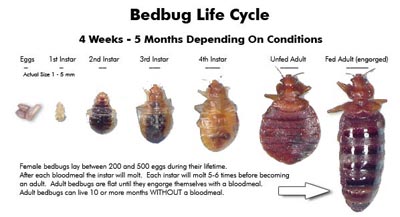 If the above description fits the bug you found, then you do in fact have bed bugs. But first you need to inform yourself of the variousbed bug spraysout there and how to use bed bug repellents, is your next step.
If the above description fits the bug you found, then you do in fact have bed bugs. But first you need to inform yourself of the variousbed bug spraysout there and how to use bed bug repellents, is your next step.
Bed bugs are a growing, worldwide problem emanating from increased global travel and decreased use of pesticides. Bed bugs have been found in five-star hotels, college residences, hospitals, and virtually all other types of housing throughout the United States. Given the nearly 30,000 students and international summer visitors who live in Stanford University's residences each year, we are fortunate to have experienced very few Bed bug cases since the issue resurfaced on a large scale in the United States a few years ago. Our peer Ivy League and University of California schools have also reported cases of Bed bugs.
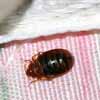 Here is some advice for you to avoid having bed bug bites. First, by covering up your body, you are helping to prevent bed bug bites. Bed bugs do not like to burrow under clothing. You may be able to avoid bed bug bites by wearing pajamas that cover up as much of your skin as possible. Secondly, it is important to note that if you are using insect repellents to keep bed bugs out, this will not help. Third, some have found that using mosquito netting that has been impregnated with permethrin, a pesticide, may help to protect you against bed bug bites while you are sleeping.
Here is some advice for you to avoid having bed bug bites. First, by covering up your body, you are helping to prevent bed bug bites. Bed bugs do not like to burrow under clothing. You may be able to avoid bed bug bites by wearing pajamas that cover up as much of your skin as possible. Secondly, it is important to note that if you are using insect repellents to keep bed bugs out, this will not help. Third, some have found that using mosquito netting that has been impregnated with permethrin, a pesticide, may help to protect you against bed bug bites while you are sleeping.
 Bed bugs had been kept under control in most industrial nations in the last century with the development of appropriate pesticides. However, as people become more global in their travels and insects of all caliber become more resistant to chemical treatments, bed bug infestations have become common in some of the finest hotels and homes in the world. The good news is that bed bugs do not transmit diseases. They do, however, leave nasty welts or blisters where they bite, which later become red and itchy.
Bed bugs had been kept under control in most industrial nations in the last century with the development of appropriate pesticides. However, as people become more global in their travels and insects of all caliber become more resistant to chemical treatments, bed bug infestations have become common in some of the finest hotels and homes in the world. The good news is that bed bugs do not transmit diseases. They do, however, leave nasty welts or blisters where they bite, which later become red and itchy.
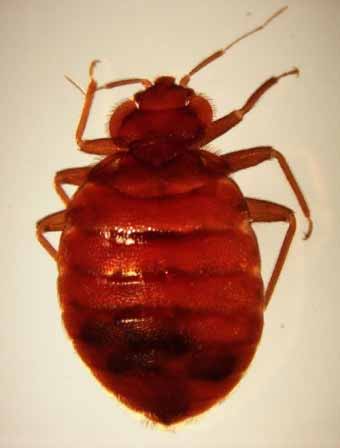 In the case of apartments and/or adjoining homes, bed bugs are able to travel by way of water pipes, wall voids, gutters and wiring. Rodents, birds, and bats can serve as alternative hosts. If a nearby habitat (see below) is the source of the insect, then it should be carefully moved away from the building and the bed bugs' entryway should be blocked. Otherwise, bed bugs have likely been introduced accidentally or are traveling between homes. Transmission of disease by bed bugs is highly unlikely, though they can harbor pathogens in their bodies. Their medical significance is mainly limited to the itching and inflammation from their bites, which can be addressed with antihistamines and corticosteroids to reduce allergic reactions and antiseptic or antibiotic ointments to prevent infection. Detecting bed bugs may be as easy as realizing you are waking up with sore spots or itchy welts, often in a line. This being said, the offending insect can rarely be identified solely by the appearance of the bites, since they can resemble bites caused by many other kinds of blood feeding insects, such as mosquitoes and fleas. Find the insects and identify them, either using the description above or by taking a specimen to an entomologist.
In the case of apartments and/or adjoining homes, bed bugs are able to travel by way of water pipes, wall voids, gutters and wiring. Rodents, birds, and bats can serve as alternative hosts. If a nearby habitat (see below) is the source of the insect, then it should be carefully moved away from the building and the bed bugs' entryway should be blocked. Otherwise, bed bugs have likely been introduced accidentally or are traveling between homes. Transmission of disease by bed bugs is highly unlikely, though they can harbor pathogens in their bodies. Their medical significance is mainly limited to the itching and inflammation from their bites, which can be addressed with antihistamines and corticosteroids to reduce allergic reactions and antiseptic or antibiotic ointments to prevent infection. Detecting bed bugs may be as easy as realizing you are waking up with sore spots or itchy welts, often in a line. This being said, the offending insect can rarely be identified solely by the appearance of the bites, since they can resemble bites caused by many other kinds of blood feeding insects, such as mosquitoes and fleas. Find the insects and identify them, either using the description above or by taking a specimen to an entomologist.
AC_AX_RunContent( 'width','640','height','385','src','https://www.youtube.com/v/AMqtC8jXvTw&hl=en_US&fs=1&','type','application/x-shockwave-flash','allowscriptaccess','always','allowfullscreen','true','movie','https://www.youtube.com/v/AMqtC8jXvTw&hl=en_US&fs=1&' ); //end AC code
How dangerous are bed bugs to humans?
Most bed bugs feed on their hosts while they are asleep. The host supplies them with blood in a painless way, never knowing it is happening. While feeding they inject a small amount of saliva into the host's skin. The more they feed on one particular host, say a human, over a period of several weeks, the more sensitized that human becomes to their saliva. Until eventually the host develops a mild to intense allergic response.
People who have become sensitive to bed bug bites - their saliva - have lesions similar to mosquito or flea bites. Most humans will think they have been bitten by some insect, such as a mosquito, and never realize who the true culprit was.
The most active time for a bed bug is about one hour before sunrise - the peak time for feeding. However, they will try to feed at any time of day or night if they are hungry enough, and if the opportunity is there. They prefer nighttime and hate sunlight.
 They will reach their host either by crawling straight towards them, or climbing a wall and then across the ceiling until they feel a heat wave - when they jump down onto their host. The bug is attracted to the host by both its warmth and the presence of C02(carbon dioxide).
They will reach their host either by crawling straight towards them, or climbing a wall and then across the ceiling until they feel a heat wave - when they jump down onto their host. The bug is attracted to the host by both its warmth and the presence of C02(carbon dioxide).
It pierces the skin of its host with two hollow tubes. One tube injects saliva which contains anesthetics, so that the host feels nothing, and anticoagulants, so that the blood flows out freely. The other tube sucks the blood in.
Feeding takes about five minutes, after which the bug returns to its hiding place. Bites are not noticeable by the host until at least a few minutes or some hours afterwards. Hosts, for example humans, will be aware of a bite after scratching it. Often bites may not be noticeable for several days.
Bed bugs will feed every five to ten days. They can, however, last for several months without feeding. If there is no food around they can become dormant for over a year. A well fed bed bug has a lifespan of about six to nine months.
How do bed bugs reproduce?
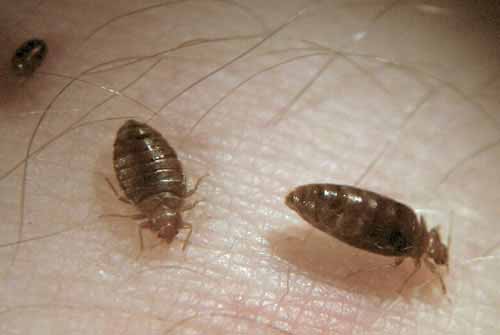 Bed bugs reproduce bytraumatic insemination, also known ashypodermic insemination. The males have hypodermic genitalia which pierce the females anywhere on their abomen and ejaculate sperm into the body cavity. The sperm diffuse through the insides and reach the ovaries, resulting in fertilization.
Bed bugs reproduce bytraumatic insemination, also known ashypodermic insemination. The males have hypodermic genitalia which pierce the females anywhere on their abomen and ejaculate sperm into the body cavity. The sperm diffuse through the insides and reach the ovaries, resulting in fertilization.
The female bed bug lays approximately 5 eggs in one day and about 500 during her lifetime. Eggs are about 1 mm long and are visible to the naked eye. They have a milky-white tinge.
The eggs take about two weeks to hatch. The nymphs (baby bed bugs) start feeding as soon as they hatch, and pass through five molting stages before reaching maturity. During each molting stage they need to feed once. It takes about five weeks to reach maturity at a room-temperature environment.
Bed bugs can only reproduce when they have reached maturity.
What happens when I get bitten?
 When you are bitten a raised red bump of flat welt (also called a papule or a wheal) will appear, often accompanied by very intense itching. The anesthetic contained in the bed bugs saliva causes an allergic reaction which results in the red bumps. They look very similar to mosquito bites, but last a lot longer. Signs and symptoms of bug bites will only affect the surface of the skin.
When you are bitten a raised red bump of flat welt (also called a papule or a wheal) will appear, often accompanied by very intense itching. The anesthetic contained in the bed bugs saliva causes an allergic reaction which results in the red bumps. They look very similar to mosquito bites, but last a lot longer. Signs and symptoms of bug bites will only affect the surface of the skin.
Bites can sometimes take up to nine days to become visible. Unlike flea bites, bed bug bites do not usually have a red dot in the center.
Bed bugs, like fleas, tend to bite in rows. There are likely to be two or three bites all in a row. This is probably because the bed bug is disturbed while feeding, and then comes back about half an inch further down for its next bite; or perhaps it had been trying to find a good vein, and needed several attempts.
About 50% of people who are bitten show no symptoms at all and do not know it happened. This makes it more difficult to prevent or identify potential infestations. Some individuals, however, may become ill and nauseous. It is possible get skin infections and scars from scratching the bites.
When people know they have an infestation of bed bugs in their house they tend to become alarmed. Research, however, indicates that bed bugs do not transmit disease, even though they do bite and take blood. Infections will occur as a result of scratching, and not from a pathogen passed on from the bug.
Very rarely, some people may have an anaphylactic reaction to bed bug bites. It is possible to have an asthmatic reaction when they shed skin as they grow and die; but cases are very rare.
Mechanical Control
Trap and remove host animals and nests. Scrub infested surfaces with a stiff brush to dislodge eggs, then vacuum. If possible, dismantle bed frame, turn over furniture and remove shelves from desks and bureaus to look for hiding insects, vacuuming to remove insects from crevices.
- Treating Bed Bug With chemicals [Last Updated On: September 19th, 2022] [Originally Added On: September 19th, 2022]
- Symptoms Picture Gallery [Last Updated On: September 20th, 2022] [Originally Added On: September 20th, 2022]
- Bed Bug Products [Last Updated On: September 21st, 2022] [Originally Added On: September 21st, 2022]
- Simplified Bed Bug Preparation [Last Updated On: September 22nd, 2022] [Originally Added On: September 22nd, 2022]
- Quality Pest Control Methods [Last Updated On: September 23rd, 2022] [Originally Added On: September 23rd, 2022]
- Pajamas Diminish Bed Bug Bites [Last Updated On: September 24th, 2022] [Originally Added On: September 24th, 2022]
- Bed Bug Picture Gallery [Last Updated On: September 25th, 2022] [Originally Added On: September 25th, 2022]
- Pesticides [Last Updated On: September 26th, 2022] [Originally Added On: September 26th, 2022]
- Male and Female Bed Bugs [Last Updated On: September 27th, 2022] [Originally Added On: September 27th, 2022]
- Affordable Bed Bug Registry Detection Method [Last Updated On: September 28th, 2022] [Originally Added On: September 28th, 2022]
- Introduction About Bed Bug [Last Updated On: September 29th, 2022] [Originally Added On: September 29th, 2022]
- Insect Bed Bug [Last Updated On: September 30th, 2022] [Originally Added On: September 30th, 2022]
- Welcome to Bed Bug Registry Database [Last Updated On: December 3rd, 2022] [Originally Added On: October 1st, 2022]
- How to Kill Bed Bugs [Last Updated On: October 2nd, 2022] [Originally Added On: October 2nd, 2022]
- How Bed Bug Bite [Last Updated On: October 3rd, 2022] [Originally Added On: October 3rd, 2022]
- Get Rid of Bed Bugs [Last Updated On: October 4th, 2022] [Originally Added On: October 4th, 2022]
- DDT for Bed Bugs [Last Updated On: October 5th, 2022] [Originally Added On: October 5th, 2022]
- Control Bed Bugs [Last Updated On: October 6th, 2022] [Originally Added On: October 6th, 2022]
- Contact Us [Last Updated On: October 7th, 2022] [Originally Added On: October 7th, 2022]
- Box Spring Treatment [Last Updated On: October 8th, 2022] [Originally Added On: October 8th, 2022]
- Bed Bug Products [Last Updated On: October 9th, 2022] [Originally Added On: October 9th, 2022]
- Bed Bug Products [Last Updated On: October 10th, 2022] [Originally Added On: October 10th, 2022]
- Bed Bug Wall or Baseboard [Last Updated On: October 11th, 2022] [Originally Added On: October 11th, 2022]
- Bed Bug Videos [Last Updated On: December 5th, 2022] [Originally Added On: October 12th, 2022]
- Bed Bug Treatment Synergy [Last Updated On: October 13th, 2022] [Originally Added On: October 13th, 2022]
- Bed Bug Treatment and Removal, How it is done [Last Updated On: October 14th, 2022] [Originally Added On: October 14th, 2022]
- Bed Bug Transmit Disease [Last Updated On: October 15th, 2022] [Originally Added On: October 15th, 2022]
- Bed Bug Tape [Last Updated On: October 16th, 2022] [Originally Added On: October 16th, 2022]
- Bed Bug Products [Last Updated On: October 17th, 2022] [Originally Added On: October 17th, 2022]
- Bed Bug Sniffing Dogs [Last Updated On: October 18th, 2022] [Originally Added On: October 18th, 2022]
- Bed Bug Spray - Non Toxic [Last Updated On: October 19th, 2022] [Originally Added On: October 19th, 2022]
- Bedbug Species [Last Updated On: October 20th, 2022] [Originally Added On: October 20th, 2022]
- Bed Bug Products [Last Updated On: October 21st, 2022] [Originally Added On: October 21st, 2022]
- Bed Bug Products [Last Updated On: October 22nd, 2022] [Originally Added On: October 22nd, 2022]
- Bed Bug Repellent [Last Updated On: October 24th, 2022] [Originally Added On: October 24th, 2022]
- Bed Bug Products [Last Updated On: October 25th, 2022] [Originally Added On: October 25th, 2022]
- Bed Bug Products [Last Updated On: October 26th, 2022] [Originally Added On: October 26th, 2022]
- Bed Bug Products [Last Updated On: October 27th, 2022] [Originally Added On: October 27th, 2022]
- Bed Bug Pillow Case Encasement Covers [Last Updated On: October 29th, 2022] [Originally Added On: October 29th, 2022]
- Bed Bug Products [Last Updated On: October 30th, 2022] [Originally Added On: October 30th, 2022]
- Bed Bug Network [Last Updated On: October 31st, 2022] [Originally Added On: October 31st, 2022]
- Bed Bug Molting [Last Updated On: November 1st, 2022] [Originally Added On: November 1st, 2022]
- Bed Bug Mattress Encasement Protector Covers [Last Updated On: November 2nd, 2022] [Originally Added On: November 2nd, 2022]
- Bed Bug Look Like [Last Updated On: November 3rd, 2022] [Originally Added On: November 3rd, 2022]
- Advanced Bed Bug Preparation [Last Updated On: November 4th, 2022] [Originally Added On: November 4th, 2022]
- Bed Bug Wall or Baseboard [Last Updated On: November 5th, 2022] [Originally Added On: November 5th, 2022]
- Bedbug Legislation [Last Updated On: November 6th, 2022] [Originally Added On: November 6th, 2022]
- Bed Bug Products [Last Updated On: November 8th, 2022] [Originally Added On: November 8th, 2022]
- Bedbug in Hotel [Last Updated On: November 9th, 2022] [Originally Added On: November 9th, 2022]
- Bedbuig in Clothes, Fabrics [Last Updated On: November 11th, 2022] [Originally Added On: November 11th, 2022]
- Bedbug History [Last Updated On: November 12th, 2022] [Originally Added On: November 12th, 2022]
- Bedbug Hiding PLaces [Last Updated On: November 13th, 2022] [Originally Added On: November 13th, 2022]
- Bed Bug Nesting Location [Last Updated On: November 14th, 2022] [Originally Added On: November 14th, 2022]
- Bed Bug Products [Last Updated On: November 15th, 2022] [Originally Added On: November 15th, 2022]
- Bedbug Feedings [Last Updated On: November 16th, 2022] [Originally Added On: November 16th, 2022]
- Bed Bug Products [Last Updated On: November 17th, 2022] [Originally Added On: November 17th, 2022]
- Bedbug Epidemic [Last Updated On: December 3rd, 2022] [Originally Added On: November 18th, 2022]
- Bed Bug Eggs and Nymphs [Last Updated On: November 19th, 2022] [Originally Added On: November 19th, 2022]
- Bed Bug Distribute [Last Updated On: November 20th, 2022] [Originally Added On: November 20th, 2022]
- Bed Bug Discrimination [Last Updated On: November 21st, 2022] [Originally Added On: November 21st, 2022]
- Bed Bug Products [Last Updated On: November 22nd, 2022] [Originally Added On: November 22nd, 2022]
- Bed Bug Colony [Last Updated On: November 23rd, 2022] [Originally Added On: November 23rd, 2022]
- Bed Bug Products [Last Updated On: November 24th, 2022] [Originally Added On: November 24th, 2022]
- Bed Bug Products [Last Updated On: November 25th, 2022] [Originally Added On: November 25th, 2022]
- Bed Bug Box Spring Encasement Covers [Last Updated On: November 26th, 2022] [Originally Added On: November 26th, 2022]
- Bed Bug Bites Pictures [Last Updated On: November 27th, 2022] [Originally Added On: November 27th, 2022]
- Bedbug Bites [Last Updated On: December 3rd, 2022] [Originally Added On: November 28th, 2022]
- Bed Bug Products [Last Updated On: November 29th, 2022] [Originally Added On: November 29th, 2022]
- Bed Bug Products [Last Updated On: December 3rd, 2022] [Originally Added On: November 30th, 2022]
- Allergy Sentry Box Spring Encasement [Last Updated On: December 1st, 2022] [Originally Added On: December 1st, 2022]
- Affordable Bed Bug Detection Method [Last Updated On: December 5th, 2022] [Originally Added On: December 2nd, 2022]
- Advanced Bed Bug Preparation [Last Updated On: December 3rd, 2022] [Originally Added On: December 3rd, 2022]
- Adult Bed Bugs [Last Updated On: December 3rd, 2022] [Originally Added On: December 4th, 2022]

